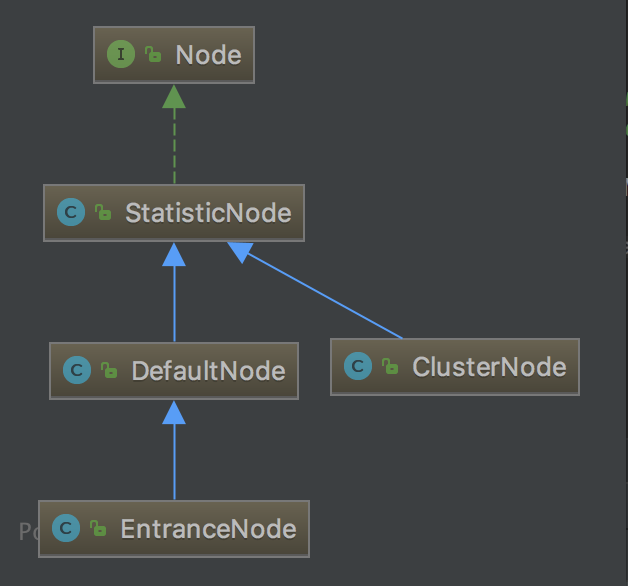准备
- 已经看过wiki 很多遍。
- 跑过测试用例和example,已经理解Sentinel的作用和大致的工作原理。
- 此博客基于版本 0.2.0,请自行准备源码。
目标
带着疑惑和问题阅读源码,理解未知的问题,和设计的优缺点。 这个项目的源码分析,直接从 SphU.entry(resource, EntryType); 入口方法往下走就可以了,比较直接。
工作原理
因为这张图很好的解释了工作原理,所以引用到这里,具体文档看wiki工作原理
重要概念
Resource : 需要保护的资源
Node : 存储资源的访问信息,资源的qps等信息
Slot : 独立功能的可插拔模块,处理具体的业务,比如限流处理等...。
Q1. Sentinel 怎么存储资源的访问信息?
Node的创建
先看看信息统计的栗子:
curl http://localhost:18990/tree?type=root
EntranceNode: machine-root(t:0 pq:0 bq:0 tq:0 rt:0 prq:0 1mp:0 1mb:0 1mt:0)
-EntranceNode: sentinel_default_context(t:0 pq:0 bq:0 tq:0 rt:0 prq:0 1mp:0 1mb:0 1mt:0)
-EntranceNode: book(t:0 pq:0 bq:0 tq:0 rt:0 prq:0 1mp:0 1mb:0 1mt:0)
--book(t:0 pq:0 bq:0 tq:0 rt:0 prq:0 1mp:0 1mb:0 1mt:0)
---/book/coke(t:0 pq:0 bq:0 tq:0 rt:0 prq:0 1mp:0 1mb:0 1mt:0)
-EntranceNode: coke(t:0 pq:0 bq:0 tq:0 rt:0 prq:0 1mp:0 1mb:0 1mt:0)
--coke(t:0 pq:0 bq:0 tq:0 rt:0 prq:0 1mp:0 1mb:0 1mt:0)
---/coke/exception(t:0 pq:0 bq:0 tq:0 rt:0 prq:0 1mp:0 1mb:0 1mt:0)
---/coke/coke(t:0 pq:0 bq:0 tq:0 rt:0 prq:0 1mp:0 1mb:0 1mt:0)
每个资源都有一个统计信息,对应存储到Node上,但是上一级的信息会是下一级信息的一个统计。 先看看Node的结构:

再来看看不同的node 功能和创建时机。
// Entrance node create in {@link ContextUtil} (对应上面的EntranceNode: book)
private static volatile Map<String, DefaultNode> contextNameNodeMap = new HashMap<String, DefaultNode>();
node = new EntranceNode(new StringResourceWrapper(name, EntryType.IN), null);
// Default node create in {@link NodeSelectorSlot} (对应上面的 --book, --/book/coke),同时会把这些资源的调用路径,以树状结构存储起来。
private volatile Map<String, DefaultNode> map = new HashMap<String, DefaultNode>(10);
node = Env.nodeBuilder.buildTreeNode(resourceWrapper, null);
// Build invocation tree
((DefaultNode)context.getLastNode()).addChild(node);
// Cluster node build in {@link ClusterBuilderSlot}(Cluter node的功能会单独讲)
private static volatile Map<ResourceWrapper, ClusterNode> clusterNodeMap
= new HashMap<ResourceWrapper, ClusterNode>();
clusterNode = Env.nodeBuilder.buildClusterNode();
node.setClusterNode(clusterNode);
Node的信息收集
到上面为止,我们的node就创建好了,之后StatisticSlot 就会进行计数和统计了
// 各个规则的校验
fireEntry(context, resourceWrapper, node, count, args);
// 如果通过就统计相应的指标
node.increaseThreadNum();
node.addPassRequest();
if (context.getCurEntry().getOriginNode() != null) {
context.getCurEntry().getOriginNode().increaseThreadNum();
context.getCurEntry().getOriginNode().addPassRequest();
}
if (resourceWrapper.getType() == EntryType.IN) {
Constants.ENTRY_NODE.increaseThreadNum();
Constants.ENTRY_NODE.addPassRequest();
}
for (ProcessorSlotEntryCallback<DefaultNode> handler :StatisticSlotCallbackRegistry.getEntryCallbacks()) {
handler.onPass(context, resourceWrapper, node, count, args);
}
Node中统计信息的使用
我们以FlowControl 为栗子, 先为 /book/coke 这个资源创建FlowControl(流量控制)的规则。
[{"controlBehavior":0,"count":1.0,"grade":1,"limitApp":"default","maxQueueingTimeMs":500,"resource":"/book/coke","strategy":0,"warmUpPeriodSec":10}]
规则校验时获取的信息. StatisticSlot
// 获取qps信息
@Override
public long passQps() {
return rollingCounterInSecond.pass() / IntervalProperty.INTERVAL;
}
我们可以看到 统计信息都是从 StatisticSlot 中获取,而最终的数据都是存在 rollingCounterInMinute 和 rollingCounterInMinute 中的,这也核心的数据结构和算法所在,我们再下一篇具体再看
private transient volatile Metric rollingCounterInSecond = new ArrayMetric(1000 / SampleCountProperty.SAMPLE_COUNT,
IntervalProperty.INTERVAL);
/**
* Holds statistics of the recent 120 seconds. The windowLengthInMs is deliberately set to 1000 milliseconds,
* meaning each bucket per second, in this way we can get accurate statistics of each second.
*/
private transient Metric rollingCounterInMinute = new ArrayMetric(1000, 2 * 60);
Q2. Slot Chain 是怎么工作的?
通过上面Node 创建过程,可以看到Node 的创建也是由各个Slot完成,每个Slot完成不同的功能然后向后传递。
Slot Chain创建过程
构造chain 在类CtSph 中创建
// 创建slot chain
ProcessorSlot<Object> chain = lookProcessChain(resourceWrapper);
/**
* Get {@link ProcessorSlotChain} of the resource. new {@link ProcessorSlotChain} will
* be created if the resource doesn't relate one.
*
* <p>Same resource({@link ResourceWrapper#equals(Object)}) will share the same
* {@link ProcessorSlotChain} globally, no matter in witch {@link Context}.<p/>
*
* <p>
* Note that total {@link ProcessorSlot} count must not exceed {@link Constants#MAX_SLOT_CHAIN_SIZE},
* otherwise null will return.
* </p>
*
* @param resourceWrapper target resource
* @return {@link ProcessorSlotChain} of the resource
*/
ProcessorSlot<Object> lookProcessChain(ResourceWrapper resourceWrapper) {
ProcessorSlotChain chain = chainMap.get(resourceWrapper);
if (chain == null) {
synchronized (LOCK) {
chain = chainMap.get(resourceWrapper);
if (chain == null) {
// Entry size limit.
if (chainMap.size() >= Constants.MAX_SLOT_CHAIN_SIZE) {
return null;
}
// 创建SlotChain的方法
chain = SlotChainProvider.newSlotChain();
Map<ResourceWrapper, ProcessorSlotChain> newMap = new HashMap<ResourceWrapper, ProcessorSlotChain>(
chainMap.size() + 1);
newMap.putAll(chainMap);
newMap.put(resourceWrapper, chain);
chainMap = newMap;
}
}
}
return chain;
}
来看看default的实现
/**
* Helper class to create {@link ProcessorSlotChain}.
*
* @author qinan.qn
* @author leyou
*/
public class DefaultSlotChainBuilder implements SlotChainBuilder {
@Override
public ProcessorSlotChain build() {
ProcessorSlotChain chain = new DefaultProcessorSlotChain();
chain.addLast(new NodeSelectorSlot());
chain.addLast(new ClusterBuilderSlot());
chain.addLast(new LogSlot());
chain.addLast(new StatisticSlot());
chain.addLast(new SystemSlot());
chain.addLast(new AuthoritySlot());
chain.addLast(new FlowSlot());
chain.addLast(new DegradeSlot());
return chain;
}
}
同时提供了自定义 builder的SPI 功能,SPI机制单独一个章节我们再看
private static void resolveSlotChainBuilder() {
List<SlotChainBuilder> list = new ArrayList<SlotChainBuilder>();
boolean hasOther = false;
// LOADER 就是对应的SPI
for (SlotChainBuilder builder : LOADER) {
if (builder.getClass() != DefaultSlotChainBuilder.class) {
hasOther = true;
list.add(builder);
}
}
if (hasOther) {
builder = list.get(0);
} else {
// No custom builder, using default.
builder = new DefaultSlotChainBuilder();
}
RecordLog.info("[SlotChainProvider] Global slot chain builder resolved: "
+ builder.getClass().getCanonicalName());
}
Slot Chain 的调用过程
Slot Chain 创建好了之后,那就从 firt开始 一个个往下执行就好了,这个流程,有接口直接定义好了,接口描述其实非常清晰,也就不再赘述。
public interface ProcessorSlot<T> {
/**
* Entrance of this slot.
*
* @param context current {@link Context}
* @param resourceWrapper current resource
* @param param Generics parameter, usually is a {@link com.alibaba.csp.sentinel.node.Node}
* @param count tokens needed
* @param args parameters of the original call
* @throws Throwable blocked exception or unexpected error
*/
void entry(Context context, ResourceWrapper resourceWrapper, T param, int count, Object... args)
throws Throwable;
/**
* Means finish of {@link #entry(Context, ResourceWrapper, Object, int, Object...)}.
*
* @param context current {@link Context}
* @param resourceWrapper current resource
* @param obj relevant object (e.g. Node)
* @param count tokens needed
* @param args parameters of the original call
* @throws Throwable blocked exception or unexpected error
*/
void fireEntry(Context context, ResourceWrapper resourceWrapper, Object obj, int count, Object... args)
throws Throwable;
/**
* Exit of this slot.
*
* @param context current {@link Context}
* @param resourceWrapper current resource
* @param count tokens needed
* @param args parameters of the original call
*/
void exit(Context context, ResourceWrapper resourceWrapper, int count, Object... args);
/**
* Means finish of {@link #exit(Context, ResourceWrapper, int, Object...)}.
*
* @param context current {@link Context}
* @param resourceWrapper current resource
* @param count tokens needed
* @param args parameters of the original call
*/
void fireExit(Context context, ResourceWrapper resourceWrapper, int count, Object... args);
总结
根据工作原理,顺着entry 方法把Sentinel的大致流程过了一遍,可能是因为设计比较合理,所以源码阅读起来比较轻松。整体过程就是构建一个个slot,每个slot处理对应的职责,并将其连起来。资源以树状的形式组织,并将统计信息存储在对应的节点上。下一篇我们将看下具体信息的存储部分,也是重要的数据结构部分。







 本文深入剖析Sentinel源码,解读其工作原理、资源访问信息存储机制及SlotChain运作流程。Sentinel通过构建一系列Slot处理不同职责,形成链式结构,有效实现资源保护。
本文深入剖析Sentinel源码,解读其工作原理、资源访问信息存储机制及SlotChain运作流程。Sentinel通过构建一系列Slot处理不同职责,形成链式结构,有效实现资源保护。


















 2455
2455

 被折叠的 条评论
为什么被折叠?
被折叠的 条评论
为什么被折叠?








